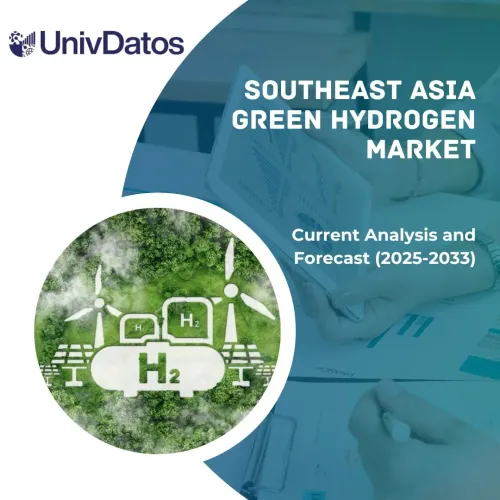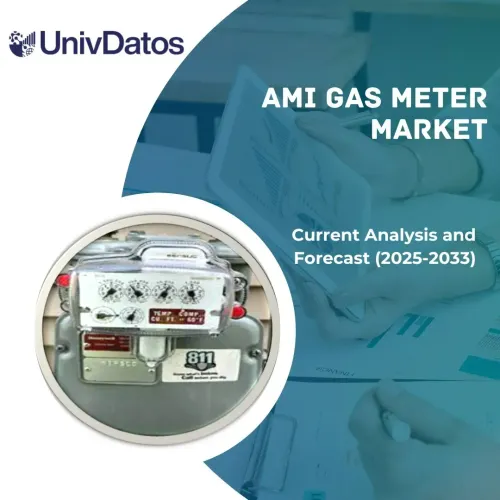- Home
- About Us
- Industry
- Services
- Reading
- Contact Us
Dry-Type Transformer Market: Current Analysis and Forecast (2022-2030)
Emphasis on Technology (Cast Resin and Vacuum Pressure Impregnated); Phase (Single-Phase and Three-Phase); Voltage (Low and Medium); Installation (Indoor and Outdoor); Rating (Less than 5 MVA, 5 MVA to 30 MVA, and More than 30 MVA); End-User (Industrial, Commercial, and Others); and Region/Country
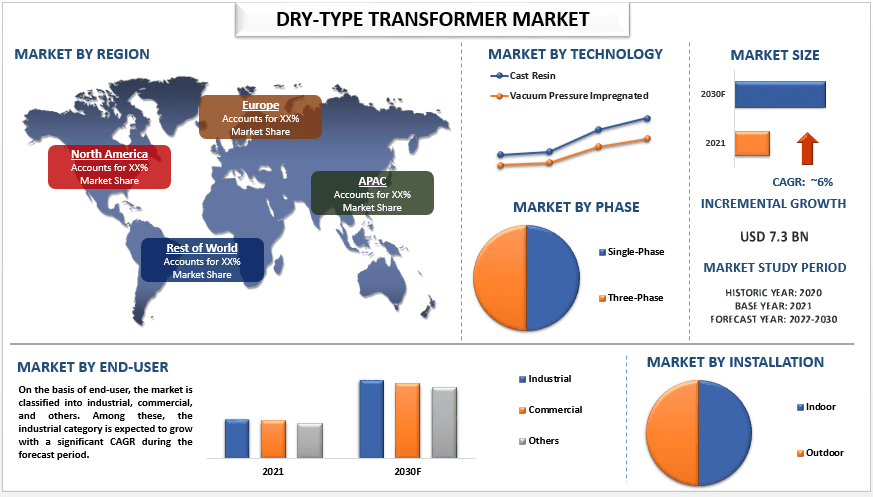
Dry-Type Transformer Market was valued at USD 7.3 billion in 2021 & is expected to grow at a CAGR of 6% from 2022-2030. Dry-Type Transformer is defined as an electrical transformer that does not use oil as a coolant or insulation medium. In addition, a dry-type transformer uses air or another inert gas as the insulating medium. Dry-type transformers are used in indoor as well as outdoor applications. To reduce the risk of fire or explosion, moisture, or corrosion, the operating environment is dry and clean as well. Dry-type transformers are typically smaller and lighter than oil-filled transformers, and they have a longer service life. Furthermore, they are also more environmentally friendly, as they do not require the use of oil. Factors such as owing to the growing demand for energy-efficient and environmentally friendly transformers. Major companies in the market offer dry-type transformers with technologically advanced features to provide reliable and sustainable transformers. For instance, in Sep 2022, Hitachi Energy launched an innovative oil-free and plug-and-play traction transformer, RESIBLOC. A rail dry-type traction transformer with an integrated cooling system is designed to reduce CO2 emissions and total operating costs while increasing energy efficiency.
Bharat Heavy Electricals Limited; Eaton; Fuji Electric Co., Ltd.; Hitachi Energy Ltd; Siemens; Hammond Power Solutions; General Electric Company; Schneider Electric; Kirloskar Electric Company; Hanley Energy are some of the key players in the market. Several M&As along with partnerships have been undertaken by these players to facilitate customers with hi-tech and innovative products/technologies.
Insights Presented in the Report
“Amongst technology, the Cast Resin category is expected to grow with a significant CAGR during the forecast period”
Based on technology, the market is bifurcated into cast resin and vacuum pressure impregnated. The Cast Resin category is expected to grow with a significant CAGR during the forecast period. This is mainly due to the multiple advantages of cast resin dry-type transformer over traditional oil-filled transformers. Factors such as higher efficiency, lower environmental impact, and longer lifespan. Furthermore, cast resin transformers are well-suited for use in a wide range of applications, including data centers, renewable energy systems, and telecommunications. Thus, increasing the demand for cast resin dry-type transformer in the market.
“Amongst end-user industrial category is expected to grow with a significant CAGR during the forecast period”
On the basis of end-user, the market is classified into industrial, commercial, and others. Among these, the industrial category is expected to grow with a significant CAGR during the forecast period. This is mainly because industrial dry-type transformers are majorly used due to higher efficiency, lower environmental impact, and longer lifespan. Industries such as manufacturing, mining, and oil and gas extraction majorly rely on electricity for power and automation, and the demand for industrial dry-type transformers is increasing.
“APAC is anticipated to hold a substantial CAGR in 2021”
APAC is anticipated to hold a substantial CAGR in 2021. This is mainly due to the increasing demand for energy-efficient and high-quality power transmission equipment. Dry-type transformers offer several advantages over traditional oil-filled transformers, such as higher efficiency, lower environmental impact, and longer lifespan. As a result, they are becoming increasingly popular among electric utilities, industrial and commercial users, and other organizations in the region. In addition, several countries with rapidly growing economies and increasing electricity demand, such as China, India, and Indonesia. These countries are investing heavily in infrastructure development and are upgrading their power transmission and distribution systems to meet the increasing electricity demand. Due to such factors, the rising demand for dry-type transformers is increasing in the region.
Dry-Type Transformer Market Report Coverage
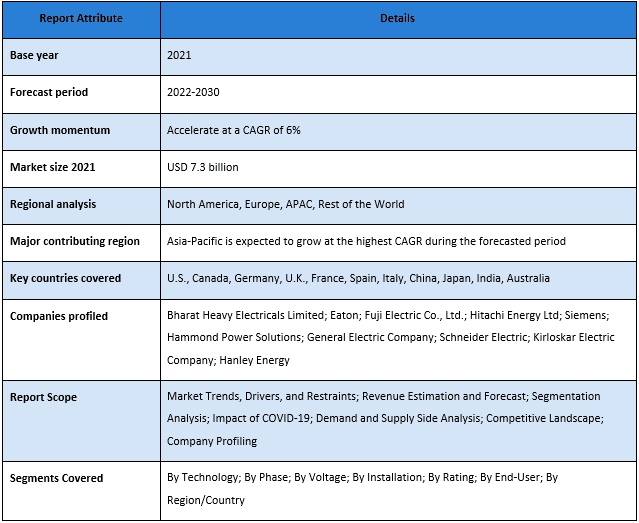
Reasons to buy this report:
- The study includes market sizing and forecasting analysis validated by authenticated key industry experts.
- The report presents a quick review of overall industry performance at one glance.
- The report covers an in-depth analysis of prominent industry peers with a primary focus on key business financials, product portfolios, expansion strategies, and recent developments.
- Detailed examination of drivers, restraints, key trends, and opportunities prevailing in the industry.
- The study comprehensively covers the market across different segments.
- Deep dive regional level analysis of the industry.
Customization Options:
The global dry-type transformer market can further be customized as per the requirement or any other market segment. Besides this, UMI understands that you may have your own business needs, hence feel free to connect with us to get a report that completely suits your requirements.
Table of Content
Research Methodology for the Dry-Type Transformer Market Analysis (2022-2030)
Analyzing the historical market, estimating the current market, and forecasting the future market of the global dry-type transformer market were the three major steps undertaken to create and analyze the adoption of dry-type transformer in major regions globally. Exhaustive secondary research was conducted to collect the historical market numbers and estimate the current market size. Secondly, to validate these insights, numerous findings and assumptions were taken into consideration. Moreover, exhaustive primary interviews were also conducted, with industry experts across the value chain of the global dry-type transformer market. Post assumption and validation of market numbers through primary interviews, we employed a top-down/bottom-up approach to forecasting the complete market size. Thereafter, market breakdown and data triangulation methods were adopted to estimate and analyze the market size of segments and sub-segments of the industry pertains to. Detailed methodology is explained below:
Analysis of Historical Market Size
Step 1: In-Depth Study of Secondary Sources:
Detail secondary study was conducted to obtain the historical market size of the dry-type transformer market through company internal sources such as annual reports & financial statements, performance presentations, press releases, etc., and external sources including journals, news & articles, government publications, competitor publications, sector reports, third-party database, and other credible publications.
Step 2: Market Segmentation:
After obtaining the historical market size of the dry-type transformer market, we conducted a detailed secondary analysis to gather historical market insights and share for different segments & sub-segments for major regions. Major segments are included in the report as technology, phase, voltage, installation, rating, and end-user. Further country-level analyses were conducted to evaluate the overall adoption of testing models in that region.
Step 3: Factor Analysis:
After acquiring the historical market size of different segments and sub-segments, we conducted a detailed factor analysis to estimate the current market size of the dry-type transformer market. Further, we conducted factor analysis using dependent and independent variables such as various technology, phase, voltage, installation, rating, and end-users of dry-type transformer. A thorough analysis was conducted for demand and supply-side scenarios considering top partnerships, mergers and acquisitions, business expansion, and product launches in the dry-type transformer market sector across the globe.
Current Market Size Estimate & Forecast
Current Market Sizing: Based on actionable insights from the above 3 steps, we arrived at the current market size, key players in the global dry-type transformer market, and market shares of the segments. All the required percentage shares split, and market breakdowns were determined using the above-mentioned secondary approach and were verified through primary interviews.
Estimation & Forecasting: For market estimation and forecast, weights were assigned to different factors including drivers & trends, restraints, and opportunities available for the stakeholders. After analyzing these factors, relevant forecasting techniques i.e., the top-down/bottom-up approach were applied to arrive at the market forecast for 2030 for different segments and sub-segments across the major markets globally. The research methodology adopted to estimate the market size encompasses:
- The industry’s market size, in terms of revenue (USD) and the adoption rate of the dry-type transformer market across the major markets domestically
- All percentage shares, splits, and breakdowns of market segments and sub-segments
- Key players in the global dry-type transformer market in terms of products offered. Also, the growth strategies adopted by these players to compete in the fast-growing market
Market Size and Share Validation
Primary Research: In-depth interviews were conducted with the Key Opinion Leaders (KOLs) including Top Level Executives (CXO/VPs, Sales Head, Marketing Head, Operational Head, Regional Head, Country Head, etc.) across major regions. Primary research findings were then summarized, and statistical analysis was performed to prove the stated hypothesis. Inputs from primary research were consolidated with secondary findings, hence turning information into actionable insights.
Split of Primary Participants in Different Regions
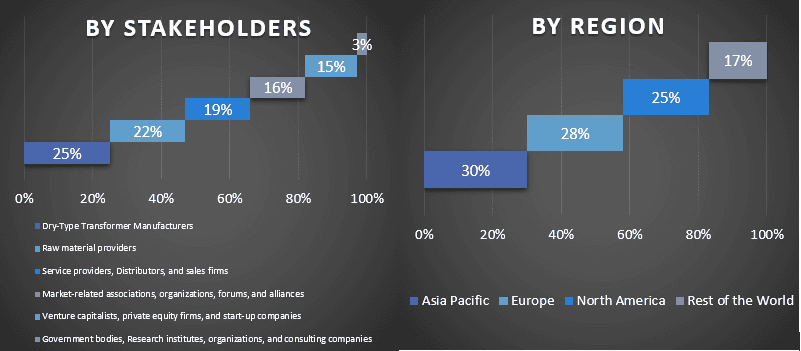
Market Engineering
The data triangulation technique was employed to complete the overall market estimation and to arrive at precise statistical numbers for each segment and sub-segment of the global dry-type transformer market. Data was split into several segments & sub-segments post studying various parameters and trends in the areas of technology, phase, voltage, installation, rating, and end-user in the global dry-type transformer market.
The main objective of the Global Dry-Type Transformer Market Study
The current & future market trends of the global Dry-type transformer market were pinpointed in the study. Investors can gain strategic insights to base their discretion for investments on the qualitative and quantitative analysis performed in the study. Current and future market trends determined the overall attractiveness of the market at a regional level, providing a platform for the industrial participant to exploit the untapped market to benefit from a first-mover advantage. Other quantitative goals of the studies include:
- Analyze the current and forecast market size of the dry-type transformer market in terms of value (USD). Also, analyze the current and forecast market size of different segments and sub-segments
- Segments in the study include areas of technology, phase, voltage, installation, rating, and end-user.
- Define and analysis of the regulatory framework for the dry-type transformer
- Analyze the value chain involved with the presence of various intermediaries, along with analyzing customer and competitor behaviors of the industry.
- Analyze the current and forecast market size of the dry-type transformer market for the major region.
- Major countries of regions studied in the report include Asia Pacific, Europe, North America, and the Rest of the World.
- Company profiles of the dry-type transformer market and the growth strategies adopted by the market players to sustain in the fast-growing market
- Deep dive regional level analysis of the industry
Related Reports
Customers who bought this item also bought






